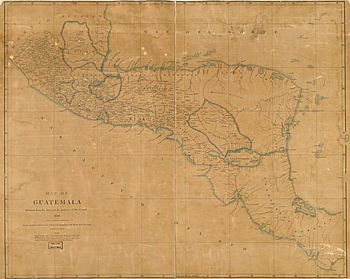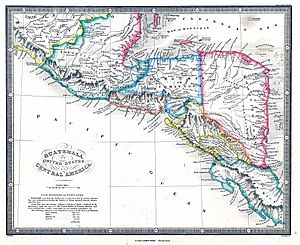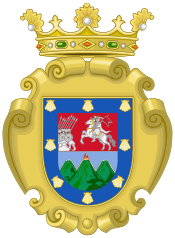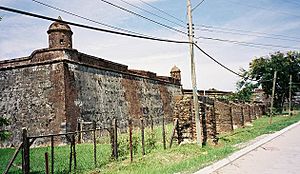Captaincy General of Guatemala facts for kids
Quick facts for kids
Captaincy General of Guatemala
Capitanía General de Guatemala
|
|||||||||||
|---|---|---|---|---|---|---|---|---|---|---|---|
| 1609–1821 | |||||||||||

Map of the provinces of the Kingdom of Guatemala.
|
|||||||||||
| Status | Spanish colony | ||||||||||
| Capital |
|
||||||||||
| Common languages | Spanish (de facto); Mayan languages | ||||||||||
| Religion | Roman Catholic | ||||||||||
| Government | Monarchy | ||||||||||
|
• 1609–1621
|
Philip III | ||||||||||
|
• 1621–1665
|
Philip IV | ||||||||||
|
• 1808–1813
|
Joseph I Bonaparte (not recognized) | ||||||||||
| Captaincy General | |||||||||||
| Legislature | Audiencia of Guatemala | ||||||||||
| Historical era | Spanish Empire | ||||||||||
|
• Established
|
1609 | ||||||||||
|
• Disestablished
|
1821 | ||||||||||
| Currency | Peso | ||||||||||
| ISO 3166 code | GT | ||||||||||
|
|||||||||||

The Captaincy General of Guatemala (Spanish: Capitanía General de Guatemala) was a large area in Central America ruled by Spain. It was also known as the Kingdom of Guatemala (Spanish: Reino de Guatemala). This region was part of the bigger New Spain (which included Mexico). It covered what is now Costa Rica, Nicaragua, Honduras, El Salvador, Guatemala, and the Mexican state of Chiapas. The main leader was called the governor-captain general. This person was also the head of the Royal Audiencia of Guatemala, which was like the highest court.
Contents
How It Started
The Spanish started exploring and settling this area in 1524. Brothers Gonzalo and Pedro de Alvarado, along with Hernán Cortés, led trips into Guatemala and Honduras. Further south, Francisco Hernández de Córdoba explored what is now Nicaragua.
Moving the Capital City
The capital city of Guatemala moved many times. On July 27, 1524, Pedro de Alvarado named the Kaqchikel city Iximche the first capital. It was called Santiago de los Caballeros de Guatemala. But the Spanish and the Kaqchikel people soon fought, making the city unsafe.
In 1526, the Spanish built a new capital at Tecpán Guatemala. Tecpán means "palace" in the Nahuatl language. This was the first lasting Spanish military base. However, the Spanish soon left it because of attacks from the Kaqchikel.
In 1527, the capital moved to the Almolonga Valley. This is where San Miguel Escobar is today, near Antigua Guatemala. In 1541, a huge mudslide from Volcan de Agua destroyed this settlement. The people who survived had to leave.
In 1543, the capital was rebuilt a few kilometers away at Antigua Guatemala. For the next 200 years, this city became very rich. But in 1776, strong earthquakes destroyed it. The city was ordered to be abandoned.
The final and current capital is the modern-day Guatemala City.
The Church's Role
The Church was very important in how Spain ruled its lands overseas. The first church areas, called dioceses, were set up in León, Nicaragua and Guatemala in 1534. Another diocese was created in Chiapas in 1539.
These dioceses were first under the Archdiocese of Seville in Spain. In 1546, they moved under the Archdiocese of Mexico. The Diocese of León moved under the Archdiocese of Lima in 1546.
In 1543, the area of the kingdom was officially set up. This happened with the creation of the Audiencia of Guatemala. This court oversaw most of Central America. It was the first group to define Central America (except Panama) as a single region under Spanish rule.
Becoming a Captaincy General
In 1609, the area became a captaincy general. This meant the governor and head of the Audiencia also became the captain general. This new title gave him power to deal with threats from other countries, especially pirates in the Caribbean. This gave the region more freedom in how it was run and defended. Other captaincies general were also created around this time.
In the 17th century, the church in Central America also became more organized. The dioceses of Comayagua and León joined the Archdiocese of Mexico in 1620 and 1647. Then, in 1743, Guatemala itself became an archdiocese. The dioceses of León, Chiapas, and Comayagua then reported to Guatemala. This made the region more united and independent in religious matters.
Later, in 1786, Spain made some changes called the Bourbon Reforms. They created new areas called intendancies. These replaced older local governments. The intendants had a lot of power over money and were supposed to help the local economy grow. New intendancies were set up in San Salvador (El Salvador), Ciudad Real (Chiapas), Comayagua (Honduras), and León (Nicaragua).
The governor-captain general of Guatemala became the main superintendent of the whole area. He also acted as the intendant for Guatemala itself. These new intendancies helped create the separate identities of the future Central American nations.
Gaining Independence
When Ferdinand VII, the King of Spain, was removed from power during a war in Spain, independence movements started. In 1811, there were small uprisings in San Salvador and León. These were quickly stopped.
In 1812, a Spanish assembly called the Cortes of Cádiz divided the region into two provinces. These were Guatemala (including Guatemala, Belize, Chiapas, Honduras, and El Salvador) and Nicaragua y Costa Rica. These provinces existed from 1812 to 1814 and again from 1820 to 1821. This was when the Spanish Constitution of 1812 was in effect.
The main governor of Guatemala remained the Captain General of Central America and Chiapas. The Captaincy General officially ended in 1821. This happened when the Act of Independence of Central America was signed. After this, the leaders of the region decided to join the First Mexican Empire.
However, most of the region peacefully left Mexico in July 1823. They then formed the United Provinces of Central America. While the region stayed together for a short time, the different provinces soon went their separate ways by 1842.
Images for kids
See also
 In Spanish: Capitanía General de Guatemala para niños
In Spanish: Capitanía General de Guatemala para niños






